|
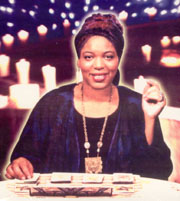 When Theo de Laurence in 1918 word for word copied Arthur E. Waite`s book "The Pictorial Key to
the Tarot" and published it under his own name together with a monocolored edition of the
Waite/Smith tarot deck, tarot found a place in esoteric circles in the USA. Like in Europe, the
number of people interested in the intricacies of the esoteric tarot and its references to the
Hebrew alphabet, to the Kabbalistic Tree of Life, to numerology and astrology were limited and it
stayed so for several decades. To comprehend the esoteric tarot in those days, as it was described in
the few books on the subject, demanded a lengthy and concentrated study, which was only for the
dedicated few.
When Theo de Laurence in 1918 word for word copied Arthur E. Waite`s book "The Pictorial Key to
the Tarot" and published it under his own name together with a monocolored edition of the
Waite/Smith tarot deck, tarot found a place in esoteric circles in the USA. Like in Europe, the
number of people interested in the intricacies of the esoteric tarot and its references to the
Hebrew alphabet, to the Kabbalistic Tree of Life, to numerology and astrology were limited and it
stayed so for several decades. To comprehend the esoteric tarot in those days, as it was described in
the few books on the subject, demanded a lengthy and concentrated study, which was only for the
dedicated few.
In the mid-to-late 1960`s, however, a new era for tarot in the USA began. With a generation of
youngsters having grown up with comic books as their primary lecture, the soil was ready. I remember
that my aunt in California after the Second World War apparently felt that her European relatives
did not only need long missed groceries, like coffee and chocolate, but also a splash of American
culture. Among the many parcels that found their way over here, she included big boxes of comic
book series featuring all kinds of heroes like Superman and Batman and whatever else they were called,
so unfamiliar and strange to me. I looked at them with amazement and read the sparsely written caption
bubbles and did not really grasp them, having grown up with stories told in words and not pictures,
as I was. I found them rather boring, so I gave them away (but I hate to think of what a treasure
they would be today, had I kept them).
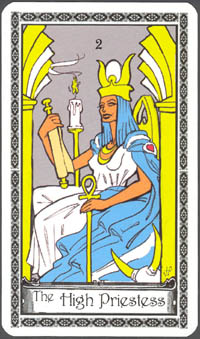
To the hippie generation in the 1960`s USA, comic books, however, were an integrated part of their
growth, and when copies of the Waite/Smith tarot deck popped up in their circles in the 1960`s,
they found an ever changing and endless comic book to read, which they did. Tarot reading became an
integrated part of the scene. People experimented with tarot, they copied, changed, and re-colored
the Waite/Smith images, publishing these variations in small editions. In the 1970`s the commercial
publishers saw the light: this was not only a passing trend but an opportunity with a lot of profit
inherent. Esoteric tarot was still only for the few, card reading became essential for the many. A
large number of popular books substituted the former texts so difficult to read: "How to Read Tarot
Cards for Yourself", "Find Your Lucky Card", "Your Daily Reading". Therapists and psychologists
followed suit, using the tarot deck as a tool for their sessions instead of former days` Rorschach
test cards, workshops were given, card readers "exchanged readings" with each other and attended
each other's workshops. Weak and undecided people became convinced that they needed a tarot reader
to help them clarify their problems, regardless if these were romantic, economic or career related.
Tarot became a mass medium and a part of many people's daily life.
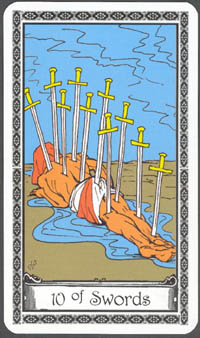
One of the more obscure of the tarot reading activities are the telephone tarot reading services.
For an amount of $4-5 per minute (!) you have access to your own so-called psychic reader, who
claims to be able to help you on with your life. One prominent telephone reader, maybe the most
prominent of them all, was Miss Cleo, the subject of this review. Miss Cleo, promoted as a
"genuine Jamaican Shaman", reached her audience through TV advertisements. In contrast to most
other TV card readers, she had no hosts around her, just sat smilingly behind a table with a stack
of cards and answered in an entertaining way and with a Caribbean accent the phone calls that came
through. After the TV show people could call another phone number and get in direct contact with
the famous reader to have their personal problems solved.
The show was a great success and went on for a long time. Then the company behind her decided to
twist the screws a bit more. They sent unsolicited messages to potential customers stating that
"Miss Cleo has had a special vision about YOU— it is important that you call her immediately!"
Persons who responded with a call were switched on to a 900 (paying/toll) number and to one of many
card tarot readers and charged for the call, often without being told there was going to be a
fee.
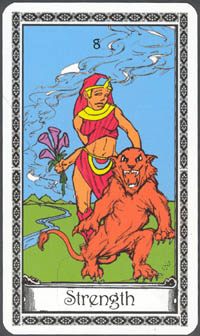 By and by, a great number of complaints led to that Attorney Generals in several U.S. states took
the company to court and eventually, of course, Miss Cleo herself was called to testify. During
her court appearance, she had to admit that she was not a Jamaican shaman after all, but an actress
named Youree Cleomili Harris, whose mother was from Florida and whose father was from Texas.
By and by, a great number of complaints led to that Attorney Generals in several U.S. states took
the company to court and eventually, of course, Miss Cleo herself was called to testify. During
her court appearance, she had to admit that she was not a Jamaican shaman after all, but an actress
named Youree Cleomili Harris, whose mother was from Florida and whose father was from Texas.
Reporters dug into the details and could soon reveal that Miss Cleo's "personal advice" were taken
directly out of a popular text book with tarot card interpretations, which resulted in another court
case, raised by the book publishers against the multimillion dollar phone syndicate controlled by
two South Florida businessmen, who were pulling the strings behind "Miss Cleo's performance. In
this connection I can mention a story I heard from a friend of mine, who worked at the sex-line of
one of the telephone service syndicates. She worked at the sex-line, which was situated on one
floor of the syndicate's building, the card readers were on another floor. When there was a lack of
tarot readers present, excessive sex-girls were sent to the card reader floor to take the calls.
The opposite, however, did not happen(!)
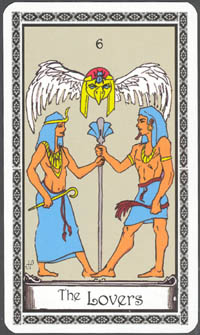
Shortly before the Miss Cleo scandal became front page news on several papers, a "Miss Cleo Tarot
deck" had been published. A large chain of pharmacies, "Walgreens" had received the exclusive
rights to distribute the Miss Cleo tarot. Many thousands of packs had been distributed to pharmacies
all over the USA. When the scandal began they were taken off the shelves and sent back.
The Miss Cleo tarot is available as a deck only, or as a set with an instructional video on tarot
reading, featuring Miss Cleo herself. The quality of the cards is fine, the faces of the characters
might be intended to look Caribbean, yet there is an obvious mixture influence from traditional
Egyptian style tarot decks and the Waite/Smith tarot. There is a small booklet enclosed also.
The presentation box which also holds the video is solid and of better quality than most similar
packing. It shall be noted that the video is in US format and not the European PAL-system.
|